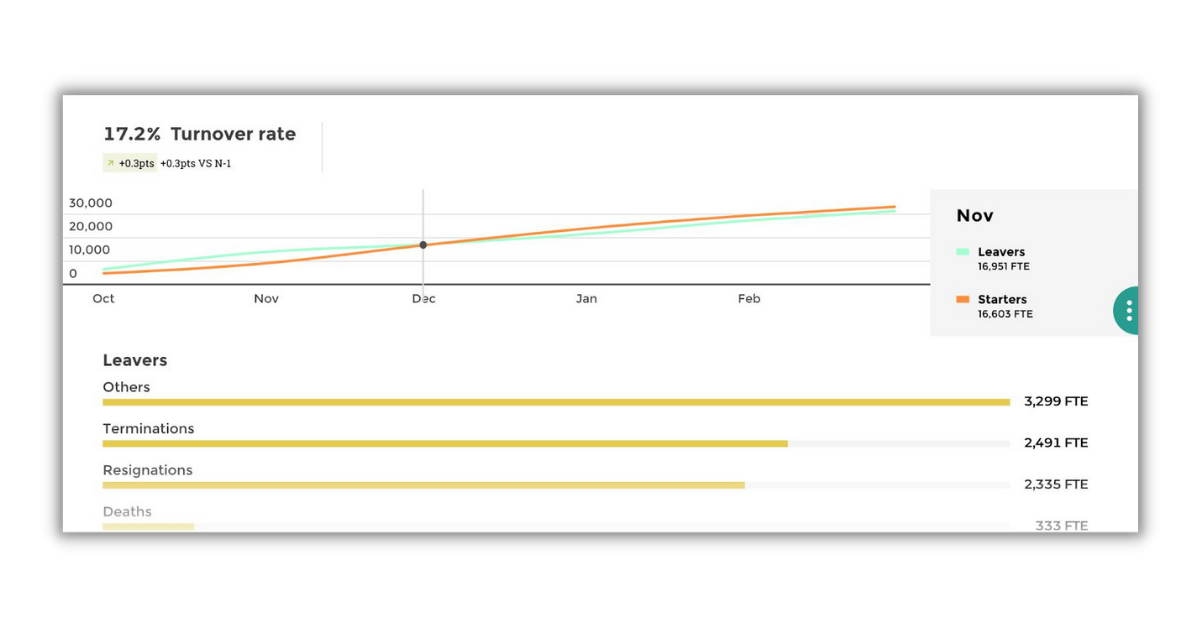What is Workforce Analytics and How it Impacts Workforce Management?
.png?width=88&height=88&name=portrait_agathe_face%20(1).png)
Agathe Huez
Publié le 24.01.22
Mis à jour le 13.01.26
3 min
Résumer cet article avec :
The use of data-driven methods for workforce planning and management is known as workforce analytics. Workforce behavior and related factors are measured and compared to overall business performance.

Analytics help aligns workforce management and HR strategy with business outcomes. Various industries are using workforce analytics platforms, and the demand for innovative workforce management applications in HR continues to grow. With key performance indicators (KPIs), workforce analytics optimizes and measures workforce planning and performance. You can use a framework to implement workforce analytics capabilities and to determine if a more advanced workforce analytics solution is right for your business.
Uses of Workforce Analytics
Answering strategy questions with workforce management relies on data analysis and software. Use it to spot trends, analyze performance and monitor these workforce analytics KPI examples.
- Recruitment and talent management: The metrics by which HR teams measure their performance at sourcing, recruiting, and hiring talent. To meet current and future hiring needs for in-demand skills, talent management metrics help monitor supply-and-demand trends.
- Employee retention: Employers need to measure employee retention to understand the impact of hiring, training, and HR management on employee tenure. Recruiting costs lost productivity with vacant roles, and training expenses can all be impacted by low retention.
- Employee experience: Interactions between a company and its candidates from the moment they begin to interact until they leave. Employees who feel appreciated and engaged are more productive and stay with the company longer. Your employees' opinions about their employer can be gauged using several methods, including employee surveys or performance reviews.
- Employee performance: Metrics to assess the effectiveness of your workforce include measuring productivity and output, as well as looking at qualitative information.
- Employee absenteeism: A habitual absence from work goes beyond regularly scheduled absences or occasional absences. This affects productivity and morale, so it should be measured and dealt with when needed.
- Training and development: Onboarding, training, and upskilling are crucial workforce planning indicators. Training spend per employee, new skill acquisition and training hours are good KPIs to measure.
Importance of Workforce Analytics
Workforce analytics is the study of employee-related data and its impact on business performance using data and statistical models. Worker-related data analysis and reporting are essential to human capital management (HCM), which refers to a set of policies and practices for hiring, developing and optimizing your workforce. Making informed decisions about how to meet improvement goals is made easier with this data. The best way to do this is with an HR management dashboard. For example, an increased turnover rate can be used to set retention goals and devise tactics to achieve those goals.
The Benefits of Workforce Analytics
Setting goals and improving performance begin with tracking performance and other analytics. This includes the following:
- Predict and prioritize hiring needs
- Optimize scheduling
- Discover labor inefficiencies
- Monitor employee engagement
- Identify staffing problems
- Create high-functioning teams
- Address skill and knowledge gaps
- Enhance onboarding and offboarding processes
- Improve employee retention
- Reduce absenteeism and turnover
- Design efficient workflows
- Control costs
- Manage and mitigate compliance risks
- Improve individual performance
- Guage employee wellness
- Increase the value of the employer brand
- Benchmark against same-sized companies

How to Implement Workforce Analytics
Workforce analytics project frameworks can be designed and implemented using the following methodology.
- Determine why: A robust workforce analytics project should address the desired business outcomes as well as the workforce issues it addresses. This can help you win over executive sponsors and project stakeholders.
- Write a project statement: Gather and interpret workforce data by incorporating internal research, industry data, studies, and the expertise of subject matter experts.
- Gather high-quality, ethical data: Identifying and selecting relevant workforce data and determining which information to collect are required in this step. Data sources should go beyond HR sources and include accounting, customer relationship management, projects and others to get a complete view of workforce behavior.
- Establish KPIs: Monitoring workforce KPIs and determining a target are equally important.
- Create workforce analytics dashboards: Engage your decision-makers with meaningful KPIs and other visualizations. Discover meaningful insights to workforce planning and management with HR dashboards that present relevant observations through real-time, interactive user-friendly visualizations and quality workforce data.
- Optimize workforce reporting: Use workforce analytics reports to translate data into clear project recommendations for project sponsors and implementation managers. Also, ensure everyone is aware of who is responsible for actionable outcomes and project conclusions.
Real-time data can be visualized using workforce analytics dashboards. It includes data to track employee experience metrics that correlate to meaningful business outcomes:
- Recruitment
- Hiring
- Onboarding
- Performance
- Engagement
- Training and Development
- Turnover
- Absenteeism
- Promotions
- Recognition
- Employee referrals
Business outcomes should be driven by human capital management strategies and not just HR teams. With workforce analytics dashboards and reports, analytics software can help your organization develop data-savvy workforce analytics and discover real-time, meaningful insights into workforce planning and management.
.png?width=112&height=112&name=portrait_agathe_face%20(1).png)
Agathe Huez
Agathe is Head of Brand & Communication at Toucan, with over 10 years of experience in marketing, branding, and corporate communication, particularly in the SaaS and tech B2B sectors. An expert in brand strategy, storytelling, and public relations, Agathe helps businesses give meaning to their communication and showcase their expertise to clients and partners. She plays a key role in growing Toucan’s visibility and positioning as a leading embedded analytics solution, both in France and internationally. On Toucan’s blog, she shares insights on how to build impactful B2B brands, create memorable experiences, and turn data into a true competitive advantage.
Voir tous les articles

